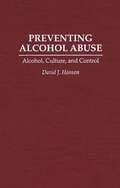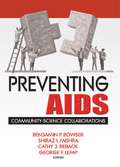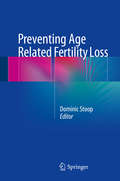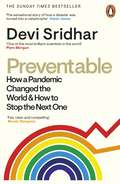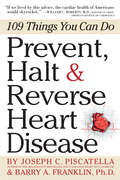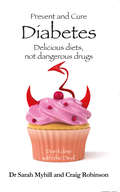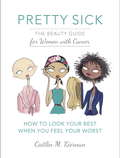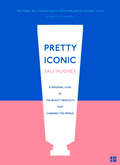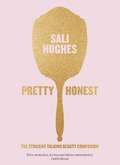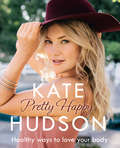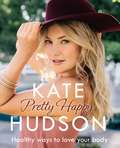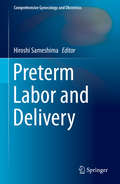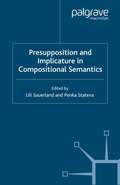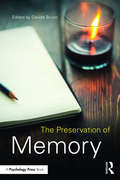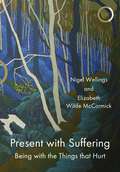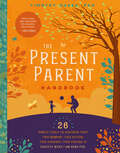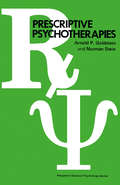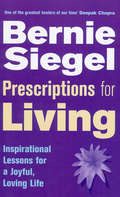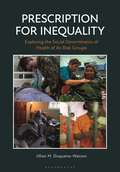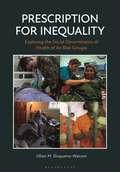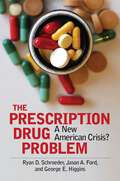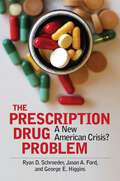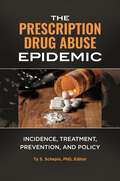- Table View
- List View
Preventing Alcohol Abuse: Alcohol, Culture, and Control
by David J. HansonThe prevailing neo-prohibitionist approach to reducing alcohol problems is generally ineffective, often counter-productive, and is doomed to failure. This work is to promote an effective alternative strategy to reducing the incidence of alcohol problems. The thesis is that a socio-cultural approach would be effective, and therefore, that public policy should promote this approach. This work is expected to be controversial, and is hoped to form a pattern for reorientation of the current approach to alcohol abuse. Professionals in drug abuse education and treatment along with public policy makers and students in appropriate courses should be interested in the work.
Preventing AIDS: Community-Science Collaborations
by R Dennis Shelby Benjamin Bowser Shiraz Mishra Cathy RebackLearn how to create professional collaboration between HIV/AIDS researchers and community organizations for the benefit of all! This book is designed to help frontline prevention organizations answer two questions that are of utmost importance. First, how effective are their services; and second, can their work be improved? The absence of rigorous evaluation is a barrier to stable funding for community organizations, and the strategies in Preventing AIDS: Community-Science Collaborations can help overcome that barrier. The book is a guide to successful cooperative efforts between researchers and community-based organizations. The information it presents will help community-based programs acquire detailed, timely information on program effectiveness and outcomes. It also provides researchers with methods for accessing hard-to-reach or hidden HIV high-risk groups. Handy tables and figures make important data easy to access and understand. In Preventing AIDS: Community-Science Collaborations, you&’ll learn about the difficult but critically important collaboration between community organizations who do frontline prevention work and university scientists who evaluate the effectiveness of that work. The book describes the community-researcher equal partner collaboration (CREPC) model for community-based collaborative research. In addition, it examines six unique efforts to prevent the spread of AIDS among high-risk populations, such as prostitutes, injection drug users, impoverished pregnant women, migrant workers, transgendered persons, and prison inmates. The case studies in Preventing AIDS: Community-Science Collaborations describe the frustrations of outreach workers and counselors who suddenly must help design a survey they fear will be intrusive, and the parallel problems faced by scientists who are told that their traditional measures mean little to outreach workers. Preventing AIDS: Community-Science Collaborations presents funders&’ perspectives on collaborative AIDS research and examines the collaborative and funding aspects of: the CAL-PEP prevention programs for drug injectors and sex workers efforts to promote HIV prevention for migrant farm workers and evaluate those efforts&’ effectiveness the ongoing collaboration between The Center for AIDS Prevention Studies (University of California, San Francisco), Centerforce (a statewide nonprofit agency providing services and advocacy to prisoners and their families), and San Quentin State Prison the effort of the Los Angeles County HIV Epidemiology Program and three community-based organizations, which collaborate to provide culturally appropriate outreach and HIV education/prevention services to transgendered individuals of various ethnic origins San Francisco&’s PHREDA project and the way its creators collaborated to better understand and serve high-risk women The U-Find-Out (UFO) Study, funded by the Universitywide AIDS Research Program of the State of California
Preventing AIDS: Community-Science Collaborations
by R Dennis Shelby Benjamin Bowser Shiraz Mishra Cathy RebackLearn how to create professional collaboration between HIV/AIDS researchers and community organizations for the benefit of all! This book is designed to help frontline prevention organizations answer two questions that are of utmost importance. First, how effective are their services; and second, can their work be improved? The absence of rigorous evaluation is a barrier to stable funding for community organizations, and the strategies in Preventing AIDS: Community-Science Collaborations can help overcome that barrier. The book is a guide to successful cooperative efforts between researchers and community-based organizations. The information it presents will help community-based programs acquire detailed, timely information on program effectiveness and outcomes. It also provides researchers with methods for accessing hard-to-reach or hidden HIV high-risk groups. Handy tables and figures make important data easy to access and understand. In Preventing AIDS: Community-Science Collaborations, you&’ll learn about the difficult but critically important collaboration between community organizations who do frontline prevention work and university scientists who evaluate the effectiveness of that work. The book describes the community-researcher equal partner collaboration (CREPC) model for community-based collaborative research. In addition, it examines six unique efforts to prevent the spread of AIDS among high-risk populations, such as prostitutes, injection drug users, impoverished pregnant women, migrant workers, transgendered persons, and prison inmates. The case studies in Preventing AIDS: Community-Science Collaborations describe the frustrations of outreach workers and counselors who suddenly must help design a survey they fear will be intrusive, and the parallel problems faced by scientists who are told that their traditional measures mean little to outreach workers. Preventing AIDS: Community-Science Collaborations presents funders&’ perspectives on collaborative AIDS research and examines the collaborative and funding aspects of: the CAL-PEP prevention programs for drug injectors and sex workers efforts to promote HIV prevention for migrant farm workers and evaluate those efforts&’ effectiveness the ongoing collaboration between The Center for AIDS Prevention Studies (University of California, San Francisco), Centerforce (a statewide nonprofit agency providing services and advocacy to prisoners and their families), and San Quentin State Prison the effort of the Los Angeles County HIV Epidemiology Program and three community-based organizations, which collaborate to provide culturally appropriate outreach and HIV education/prevention services to transgendered individuals of various ethnic origins San Francisco&’s PHREDA project and the way its creators collaborated to better understand and serve high-risk women The U-Find-Out (UFO) Study, funded by the Universitywide AIDS Research Program of the State of California
Preventing Age Related Fertility Loss
by Dominic StoopThis unique book provides expert advice on all the different aspects related to fertility preservation for age related infertility. Although, there is a lot of information available on the Internet and in books about fertility preservation for cancer treatment, little information is available for young women that are confronted with a ticking biological clock. While men have been able to cryopreserve sperm since the 1950s, women have only recently gained the opportunity to preserve their gametes through the egg vitrification technique. Therefore, many women confronted with a risk of imminent fertility loss, such as chemotherapy, are now freezing their oocytes instead of embryos. Successful oocyte cryopreservation offers them a reproductive autonomy independent of men. Moreover, it now enables single women to preserve their reproductive chances. The most important threat for female fertility is ovarian aging as it causes a progressive decline in the reproductive chances. The general trend to delay motherhood due to societal changes confronts many women and couples with a diminished fertility. This fertility problem can often not be cured by in vitro fertilization, which makes that an increasing number of women require oocyte donation as the treatment of last resort. In the last few years, fertility centres around the world have started to offer the opportunity cryopreserve oocytes to young, often highly educated, single women. This patient population is unique as compared to other patients in the fertility clinic as they perform a preventive treatment. They are neither confronted with infertility nor are they undergoing a treatment that might cause an imminent treat to their fertility.
Preventable: How a Pandemic Changed the World & How to Stop the Next One
by Devi Sridhar*BBC RADIO 4 BOOK OF THE WEEK*Preventable tells the extraordinary story of COVID-19 and how global politics shape our health - from a world-leading expert and the pandemic's go-to science communicatorProfessor Devi Sridhar has risen to prominence for her vital roles in communicating science to the public and speaking truth to power. In Preventable she highlights lessons learned from outbreaks past and present in a narrative that traces the COVID-19 pandemic - including her personal experience as a scientist - and sets out a vision for how we can better protect ourselves from the inevitable health crises to come.In gripping and heartfelt prose, Sridhar exposes the varied realities of those affected (from the jailed doctor in Wuhan who sounded the alarm, and the bored passengers marooned on the Diamond Princess cruise ship, to the daily nightmares of exhausted healthcare workers), and puts you in the room with key decision makers at crucial moments (from over-confident heads of states and their hesitant scientific advisors, to the beleaguered leaders of global health organisations). Sridhar vibrantly conveys the twists and turns of a plot that saw: deadlier variants emerge (contrary to the predictions of social media pundits who argued it would mutate to a milder form); the Pyrrhic victory in many countries of the false narrative of health versus the economy (those countries which controlled the virus, like Taiwan and Denmark, had a steadier recovery); countries with weak health systems like Senegal and Vietnam fare better than countries like the US and UK (which were consistently ranked as the most prepared); and the quickest development of game-changing vaccines in history (and their unfair distribution). Combining science, politics, ethics and economics, this definitive book dissects the global structures that determine our fate, and reveals the deep-seated economic and social inequalities at their heart - it will challenge, outrage and inspire.'A brutally compelling reminder that if voices like Devi's had been listened to, so many more could have lived' OWEN JONES'One of the most brilliant scientists in the world who has been proven consistently right in this crisis' PIERS MORGAN'Excellent . . . Fair, clear and compelling' NICOLA STURGEON'Those who have found Professor Devi Sridhar's expertise and calm advice invaluable since the arrival of Covid-19 will be glad to know that she has written Preventable' RACHEL COOKE, Guardian, Non-fiction to look out for in 2022
Prevent, Halt & Reverse Heart Disease: 109 Things You Can Do
by Barry Franklin Ph.D. Joseph C. PiscatellaWhen your doctor delivers the news—you have heart disease, which afflicts one in three Americans (an estimated 81 million people)—you need exactly the kind of indispensable, plainspoken advice found in Prevent, Halt & Reverse Heart Disease. You need Joe Piscatella. A lay expert who’s been lecturing to health professionals and Fortune 500 corporations for three decades, and who is one of the longest-lived survivors of bypass surgery— 32 years and counting—Piscatella shows how to take charge of one’s cardiac health in a bold yet simple, easily understandable way.Created by Mr. Piscatella and Dr. Barry Franklin, one of the nation’s top cardiac rehab specialists, Prevent, Halt & Reverse Heart Disease was originally published in 2003 and is now completely revised and updated with the latest research on managing the #1 killer of American men and women. The book is divided into three sections: Cardiac Markers (10 of the most important risk factors are examined so that you can assess your risk and understand what the doctor is telling you); Life Skills (the 109 practical tips, from #3 increase your HDL level to #22 breathe deeply to #99 know your margarines to #109 floss your teeth); and Cardiac Basics (an explanation of contemporary tests and treatments). Throughout is information updated since the first edition, such as the recommended dose of baby aspirin per day, the importance of sleep, a smarter way to read food tables, the PLAC test, and more.
Prevent and Cure Diabetes: Delicious Diets, Not Dangerous Drugs: Don't Dine With The Devil
by Sarah Myhill Craig RobinsonWe are probably all aware that countries with the Western lifestyle and the standard Western diet are facing an epidemic of type 2 diabetes. Already in 2010, more than one million people in the UK were thought to have undiagnosed type 2 diabetes, double the previous estimate, and as long ago as 2008 between 20% and 30% of the adult population could be characterised as having the ‘metabolic syndrome’ – the forerunner to diabetes. The tragedy is that most people with these conditions regard them as inevitable evils and agree to take the medicine – or inject the insulin – when the time comes. BUT it need not be that way. As Dr Myhill writes: ‘All medical therapies should start with diet. Modern Western diets are driving our modern epidemics of diabetes, heart disease, cancer and dementia; this process is called metabolic syndrome. In this book I explain in detail why and how we have arrived at a situation where the real weapons of mass destruction can be found in our kitchens. Importantly, the book describes the vital steps every one of us can make to reverse the situation so that life can be lived to its full potential.’ Based on Dr Myhill’s more than 30 years’ experience of helping her patients return to health, find out: What metabolic syndrome is, why Westerners are all on the way to getting it, and how to avoid it; What the risk factors are for developing diabetes and how to minimise these; How to reverse diabetes type 2; How to control blood sugar with minimal use of insulin in diabetes type 1; How to balance your blood sugar levels and monitor your progress.
Pretty Sick: The Beauty Guide for Women with Cancer
by Caitlin KiernanThe ultimate resource to looking your best during and after cancer treatment, from a veteran beauty industry insider. Like many women who receive the shattering diagnosis of cancer, Caitlin Kiernan was concerned about her health and her future, but also about how the treatment would affect how she felt and looked - would she lose her hair? Would she lose her nails? How would she look after a double mastectomy?But unlike other women who battle cancer, Kiernan has spent her entire career as a beauty editor, beauty director (most recently for Life & Style Weekly), and now beauty producer. As someone who works in the public eye and in the fashion industry, Kiernan had to quickly learn how to look her best even when she was feeling her worst. So she called on her list of extensive contacts and beauty insiders - from hair professionals to top medical doctors (at institutions like Memorial Sloan Kettering and Mt Sinai Hospital) to style mavens and even celebrities (including Wendy Williams and Hoda Kotb) - to gather the best and most useful beauty tips for cancer treatment.The result is Pretty Sick: the ultimate guide to beauty during (and after) cancer treatment, covering skin care, hair care (and wig shopping), nail care, makeup, an explanation of breast cancer surgical options, style advice for life post mastectomy, and much, much more. Illustrated with charming line drawings and peppered with advice from celebrities and cancer survivors, Pretty Sick will be a welcome and trusted resource during treatment, helping women to look their best even when they don't feel their best.
Pretty Iconic: A Personal Look At The Beauty Products That Changed The World
by Sali HughesOver 200 iconic products that are among the best and most influential in the beauty world – past, present and future. ‘Sali Hughes has created a universe filled with galaxies of beauty secrets’ Charlotte Tilbury
Pretty Honest: The Straight-talking Beauty Companion
by Sali HughesA witty, wise and truthful beauty handbook for real women on what works in real life from Sali Hughes, beloved journalist and broadcaster.
Pretty Happy: The Healthy Way To Love Your Body
by Kate HudsonA smart health and fitness bible from inspirational actress Kate Hudson.
Pretty Happy: The Healthy Way To Love Your Body
by Kate HudsonA smart health and fitness bible from inspirational actress Kate Hudson.
Preterm Labor and Delivery (Comprehensive Gynecology and Obstetrics)
by Hiroshi SameshimaThis splendid volume presents numerous aspects of preterm labor and delivery, from its fundamental mechanism to clinically focused approaches. The incidence of preterm delivery is 6-7% in Japan, while globally up to 10% of pregnancies with preterm labor result in premature delivery. The rates of overall survival and intact survival of the premature infants are also excellent in Japan. Thus Japan’s approach to preterm labor and delivery has long attracted attention. In each chapter, experts describe specific issues unique to conditions in Japan, including diagnosis, tocolytic agents, definition of clinical chorioamnionitis, treatment of bacterial vaginosis, role of amniocentesis, management of preterm premature membrane rupture and also placental pathology, presenting definitive evidence of the reduced incidence of preterm delivery in Japan. This book benefits not only obstetricians, pediatricians and gynecologist, but also midwives, nurse practitioners, and medical and associated staffs in the field of obstetrics, pediatrics, as well as neonatal and perinatal medicine who are involved in delivery.
Presupposition and Implicature in Compositional Semantics (Palgrave Studies in Pragmatics, Language and Cognition)
by U. Sauerland P. StatevaAll humans can interpret sentences of their native language quickly and without effort. Working from the perspective of generative grammar, the contributors to this volume investigate three mental mechanisms, widely assumed to underlie this ability: compositional semantics, implicature computation and presupposition computation.
The Preservation of Memory
by Davide BrunoAn increase in average life expectancy has given rise to a number of pressing health challenges for the 21st century. Age-related memory loss, whether due to a neurodegenerative condition such as Alzheimer’s disease, or as a product of the normal process of aging, is perhaps the most significant of the health problems of old age presently confronting our society. The Preservation of Memory explores non-invasive, empirically sound strategies that can be implemented to ensure long-lasting and effective retention of information. The chapters in this volume describe and evaluate both well-established and novel methods for improving and strengthening memory, for people with and without dementia. They also look at ways in which effective detection and care can be implemented, and describe empirical findings that can be translated into everyday practice. The contributors take a multidisciplinary approach, motivated by the desire to look beyond and across boundaries to find new areas of knowledge and new opportunities. The Preservation of Memory will be useful reading for students and researchers focusing upon memory, aging and dementia, and also for mental health practitioners, social workers, and carers of persons living with dementia or other memory impairments.
The Preservation of Memory
by Davide BrunoAn increase in average life expectancy has given rise to a number of pressing health challenges for the 21st century. Age-related memory loss, whether due to a neurodegenerative condition such as Alzheimer’s disease, or as a product of the normal process of aging, is perhaps the most significant of the health problems of old age presently confronting our society. The Preservation of Memory explores non-invasive, empirically sound strategies that can be implemented to ensure long-lasting and effective retention of information. The chapters in this volume describe and evaluate both well-established and novel methods for improving and strengthening memory, for people with and without dementia. They also look at ways in which effective detection and care can be implemented, and describe empirical findings that can be translated into everyday practice. The contributors take a multidisciplinary approach, motivated by the desire to look beyond and across boundaries to find new areas of knowledge and new opportunities. The Preservation of Memory will be useful reading for students and researchers focusing upon memory, aging and dementia, and also for mental health practitioners, social workers, and carers of persons living with dementia or other memory impairments.
Present with Suffering: Being with the Things that Hurt
by Nigel Wellings Elizabeth Wilde McCormickWhat is the place of discontent and unhappiness in human experience and how best can we be with it? There is something about everything that makes it not quite satisfactory. Even things we really love are spoilt by not being quite enough or by going on too long. People entering psychotherapy want to feel better – more authoritative, less anxious or depressed, more whole – and although it can help, an enormous amount of difficult and painful emotions continue to arise. Even after years and years of therapy many of us feel that there is no ‘happy ever after’. Bearing this reality in mind and drawing upon both psychotherapeutic and Buddhist sources, Present with Suffering, explores bereavement and our pervasive experience of emptiness. It shows how through being mindfully present, kind and accepting, we may enfold what hurts us in a more spacious and meaningful way.
The Present Parent Handbook: 26 Simple Tools to Discover that This Moment, This Action, This Thought, This Feeling Is Exactly Why I Am Here
by Timothy DukesThe Present Parent Handbook addresses both the dilemmas and delights in each parenting moment, providing practices to manage both. With an A-Z approach, parents will learn how to be more mentally and emotionally available to their children.
Prescriptive Psychotherapies: Pergamon General Psychology Series
by Arnold P. Goldstein Norman SteinPrescriptive Psychotherapies describes a prescriptive approach to psychotherapeutic treatment. At the heart of this prescriptive model is the patient X therapist X treatment interactionist view of the question ""Which type of patient, meeting with which type of therapist, for which type of treatment will yield which outcomes?"" The diagnostic, research, and therapeutic implications of this viewpoint are examined. Attention is also devoted to the question of how prescriptive psychotherapy research might be most advantageously conducted to yield prescriptive information leading to increasingly successful treatment outcomes. This book is comprised of 15 chapters and begins by explaining the value and development of prescriptive psychotherapies and suggesting a schema for both conceptualizing and generating investigations that may yield progressively more useful psychotherapeutic prescriptions. The next chapter considers the views of others regarding issues bearing upon the prescriptive process, particularly the role of diagnosis. The treatment and research implications of psychological testing are then explored, along with the role of assessment in behavior modification. Several of the key issues in the process of achieving effective application of the integrated insight-behavioral approach to psychobehavioral counseling and therapy are also examined. Examples of clinical prescriptions of prescriptive psychotherapies are given, including psychoneuroses, psychophysiological disorders, and sexual deviations. This monograph is addressed to both clinicians and researchers concerned with the conduct and effectiveness of psychotherapy.
Prescriptions For Living: Inspirational Lessons for a Joyful, Loving Life (Prescriptions For Living Ser.)
by Dr Bernie SiegelA pioneer in mind-body medicine, Dr Bernie Siegel has led the way in demonstrating how a positive attitude and an ability to give and receive love can influence our health, our ability to heal and most importantly, the quality of our lives. In this extraordinary book he addresses all of us who are seeking a more joyful and productive life, and uses personal anecdotes and touching stories that go far beyond his previous work. Full of wise insights and Siegel's deep compassion, Prescriptions for Living undoubtedly has the ability to transform our lives.
Prescription for Inequality: Exploring the Social Determinants of Health of At-Risk Groups
by Jillian M. Duquaine-WatsonThis book explores how social determinants of health (SDH) impact the health of a variety of marginalized demographic groups in the United States. Chapters focus on the 13 groups that research demonstrates are most disadvantaged by SDH and, consequently, who suffer the most from ongoing health disparities in America. This includes Black and Hispanic individuals, the LGBTQIA+ community, women, the elderly, people with disabilities, veterans, and those living in rural areas, among others.Chapters follow a standardized format that makes it easy for readers to focus in on aspects of the subject that are of greatest interest. Each profile begins with a snapshot of that group's current state of health, including the biggest medical concerns and how other determinants of health may play a role. Next, each chapter takes an in-depth look at the four components of SDH: economic factors, educational access and quality, healthcare access and quality, and living environment and social context. Unique problems and possible solutions are explored within each of these four sections. An end-of-volume bibliography and further readings list points readers who wish to continue their investigation of the topic toward additional information.Relying on an interdisciplinary framework, the book incorporates research from diverse fields including public health, feminist theory, critical studies of race and ethnicity, poverty studies, disability studies, aging studies, cultural competence, legal studies, and global health. In recognition of the reality that health disparities are the result of a complex interplay of forces and structural factors that permeate American culture, analysis extends beyond health and health care to include a broad range of interrelated social, political, economic, and educational components.
Prescription for Inequality: Exploring the Social Determinants of Health of At-Risk Groups
by Jillian M. Duquaine-WatsonThis book explores how social determinants of health (SDH) impact the health of a variety of marginalized demographic groups in the United States. Chapters focus on the 13 groups that research demonstrates are most disadvantaged by SDH and, consequently, who suffer the most from ongoing health disparities in America. This includes Black and Hispanic individuals, the LGBTQIA+ community, women, the elderly, people with disabilities, veterans, and those living in rural areas, among others.Chapters follow a standardized format that makes it easy for readers to focus in on aspects of the subject that are of greatest interest. Each profile begins with a snapshot of that group's current state of health, including the biggest medical concerns and how other determinants of health may play a role. Next, each chapter takes an in-depth look at the four components of SDH: economic factors, educational access and quality, healthcare access and quality, and living environment and social context. Unique problems and possible solutions are explored within each of these four sections. An end-of-volume bibliography and further readings list points readers who wish to continue their investigation of the topic toward additional information.Relying on an interdisciplinary framework, the book incorporates research from diverse fields including public health, feminist theory, critical studies of race and ethnicity, poverty studies, disability studies, aging studies, cultural competence, legal studies, and global health. In recognition of the reality that health disparities are the result of a complex interplay of forces and structural factors that permeate American culture, analysis extends beyond health and health care to include a broad range of interrelated social, political, economic, and educational components.
The Prescription Drug Problem: A New American Crisis?
by Ryan D. Schroeder Jason A. Ford George E. HigginsProviding an indispensable resource for undergraduate students, graduate students, and policymakers interested in the prescription drug abuse crisis in the United States, this book summarizes the current state of prescription drug abuse and its growth over the past 20 years.The Prescription Drug Problem analyzes the growth of the prescription drug abuse problem from 1994 to 2014 and includes comparisons to marijuana and hard drug use during the same period. Specific attention is given to prescription opiate abuse and the transition from prescription opiates to heroin. The book begins with a broad overview of the prescription drug problem in the U.S., while the text presents stories of celebrities who have struggled with prescription drug abuse, highlights a handful of ordinary Americans who are battling prescription drug abuse, and examines as case studies a few communities that have been ravaged by prescription drug abuse. Drawing upon demographic patterns of abuse to identify causes of and factors contributing to prescription drug abuse as well as possible solutions to the problem, the book is designed to provide a broad overview of the prescription drug abuse problem in the U.S. and stimulate additional research.
The Prescription Drug Problem: A New American Crisis?
by Ryan D. Schroeder Jason A. Ford George E. HigginsProviding an indispensable resource for undergraduate students, graduate students, and policymakers interested in the prescription drug abuse crisis in the United States, this book summarizes the current state of prescription drug abuse and its growth over the past 20 years.The Prescription Drug Problem analyzes the growth of the prescription drug abuse problem from 1994 to 2014 and includes comparisons to marijuana and hard drug use during the same period. Specific attention is given to prescription opiate abuse and the transition from prescription opiates to heroin. The book begins with a broad overview of the prescription drug problem in the U.S., while the text presents stories of celebrities who have struggled with prescription drug abuse, highlights a handful of ordinary Americans who are battling prescription drug abuse, and examines as case studies a few communities that have been ravaged by prescription drug abuse. Drawing upon demographic patterns of abuse to identify causes of and factors contributing to prescription drug abuse as well as possible solutions to the problem, the book is designed to provide a broad overview of the prescription drug abuse problem in the U.S. and stimulate additional research.
The Prescription Drug Abuse Epidemic: Incidence, Treatment, Prevention, and Policy
by Ty S. SchepisThis overview of prescription drug abuse includes historical background, key concepts, and discussion of the prevalence of drug abuse, treatments, and policy issues implicated in ending the epidemic.Prescription opioid medication abuse has been declared a national crisis by experts in medicine, substance use, public health, and pain management, culminating in a declaration made by the President of the United States that opioid misuse and abuse is a national health emergency. In this comprehensive text, expert scholars analyze and address a wide range of issues in, obstacles to, and potential solutions for this emergency, which caused more than 50,000 deaths in 2016 alone. It covers a variety of topics related to prescription misuse from both clinical and academic perspectives. After an opening containing background material on the most commonly misused medications, chapters examine subgroups engaged in misuse and special medical environments where misuse issues are key. They then cover U.S. policy, perspectives outside the U.S., and theories that may explain the misuse phenomena. This book will serve as a resource for students and professionals in fields related to prescription drug abuse—including psychology, sociology, medicine, and public policy—and is accessible to individuals not trained in these fields.
